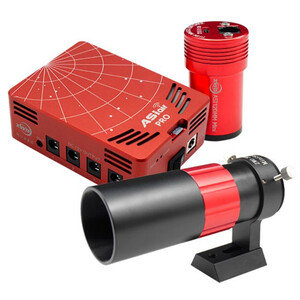

#ASTROGUIDER PC#
You can also autoguide using the pulse-guiding method that utilizes a direct connection from your PC to the telescope mount. This image of the Veil Nebula was captured on an affordable equatorial mount using autoguiding.Īutoguiding is accomplished by sending small corrections to your telescope mount via an ST-4 cable communicating from your guide camera to the mount. This is because we are now “sampling” a smaller (zoomed-in) area of the night sky that can potentially highlight the smallest amount of period error in your telescope mount.

Even the slightest amount of periodic error can ruin a long exposure image of your target.Īs you increase the focal length of your telescope, autoguiding becomes more important. However, to do this requires extreme accuracy from your equatorial telescope mount as it slowly tracks the apparent movement of the sky. This makes being able to consistently capture long exposure images with sharp, focused details a real benefit for astrophotography. You’ll often reveal much more signal on a deep-sky object in a 5-minute exposure than you would in 30-seconds. Whether you’re shooting with a DSLR or a dedicated astronomy camera, capturing longer exposures means that more light (or signal) can be recorded in a single shot. They’re really not that hard to get up and running, and they can make a big difference to the quality of your images. The great news is, there are more compact and affordable solutions available than ever before.īelow, I’ll offer you some affordable autoguiding solutions that I have personally used to guide a number of telescope setups. I’ll admit that autoguiding can seem a bit daunting in the early stages of building your first deep-sky astrophotography kit. Basic Autoguiding for Astrophotography Made Simple The ZWO 30mm Guide Scope is ultra-small and adds very little weight to your telescope. I started out with an Orion 50mm Mini Guide scope package way back in 2011, and this is still a popular starter system for many backyard imagers. Keeping weight to a minimum has many advantages and a miniature system like the one shown below is an attractive option for beginners.

If you are looking to add a small guide scope package to your existing astrophotography setup, you can build a system using the components of your choice, or invest in a guide scope package that’s ready to go. The setup above shows a William Optics Zenithstar 73 refractor with a 50mm guide scope and camera mounted on top.
#ASTROGUIDER TRIAL#
With the right equipment and a little trial and error, you’ll wonder how you ever lived without it. I’ve been using a small “ guide scope” with an autoguiding camera to take longer exposures through my telescope for several years. Many amateur astrophotographers are hesitant to add any additional complexity to an already steep learning curve, but the truth is, autoguiding your camera and telescope isn’t overly difficult to execute.
#ASTROGUIDER HOW TO#
Autoguiding a Telescope for Deep-Sky Astrophotographyīelow, I’ll explain how to start leveraging the power of autoguiding for deep-sky astrophotography.


 0 kommentar(er)
0 kommentar(er)
